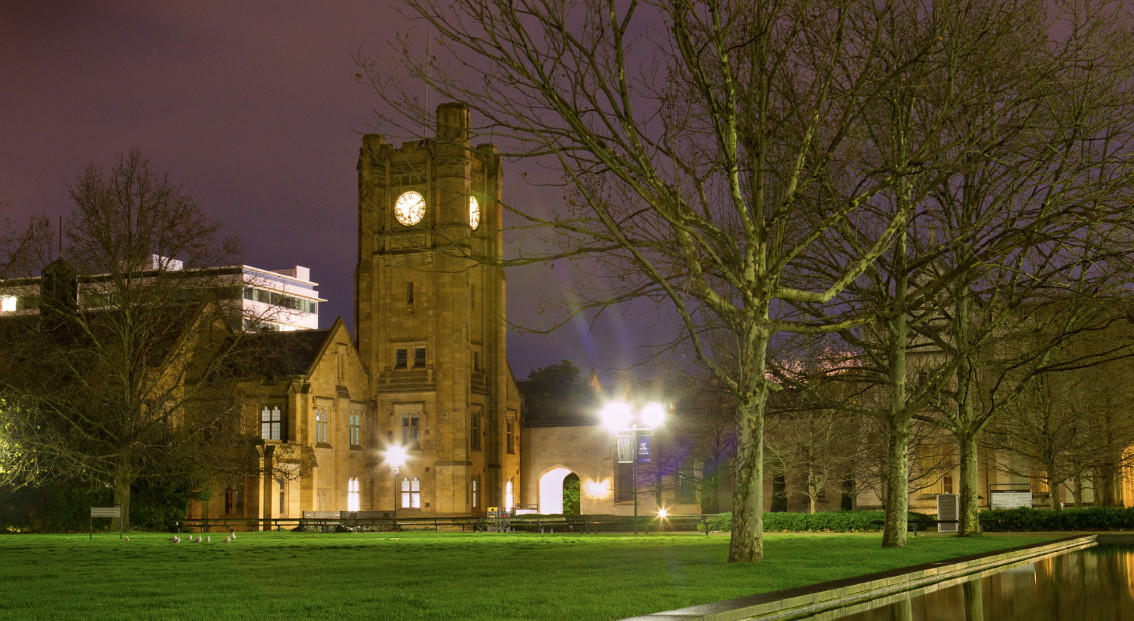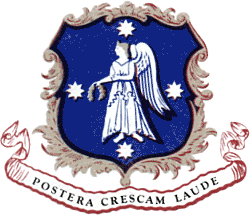Difference between revisions of "University of Melbourne"
(→Coat of Arms) |
|||
| Line 18: | Line 18: | ||
<br> | <br> | ||
The university's coat of arms is a blue shield on which a depiction of "Victory" in white colour holds her laurel wreath over the stars of the Southern Cross. The motto, Postera crescam laude ("Later I shall grow by praise" or, more freely, "We shall grow in the esteem of future generations"), is written on a scroll beneath the shield. The Latin is from a line in Horace's Odes: ego postera crescam laude recens. | The university's coat of arms is a blue shield on which a depiction of "Victory" in white colour holds her laurel wreath over the stars of the Southern Cross. The motto, Postera crescam laude ("Later I shall grow by praise" or, more freely, "We shall grow in the esteem of future generations"), is written on a scroll beneath the shield. The Latin is from a line in Horace's Odes: ego postera crescam laude recens. | ||
| + | |||
| + | == History of the University == | ||
| + | The University of Melbourne was established by Hugh Childers, the Auditor-General and Finance Minister, in his first Budget Speech on 4 November 1852, who set aside a sum of £10,000 for the establishment of a university. The university was established by Act of Incorporation on 22 January 1853, with power to confer degrees in arts, medicine, laws and music. The act provided for an annual endowment of £9,000, while a special grant of £20.000 was made for buildings that year. The foundation stone was laid on 3 July 1854, and on the same day the foundation stone for the State Library. Classes commenced in 1855 with three professors and sixteen students; of this body of students, only four graduated. The original buildings were officially opened by the Lieutenant Governor of the Colony of Victoria, Sir Charles Hotham, on 3 October 1855. The first chancellor, Redmond Barry (later Sir Redmond), held the position until his death in 1880. | ||
| + | |||
| + | The inauguration of the university was made possible by the wealth resulting from Victoria's gold rush. The institution was designed to be a "civilising influence" at a time of rapid settlement and commercial growth. | ||
| + | |||
| + | In 1881, the admission of women was a seen as victory over the more conservative ruling council. | ||
| + | |||
| + | The university's 150th anniversary was celebrated in 2003. | ||
| + | |||
| + | == Governance == | ||
| + | Governance of the university is grounded in an act of parliament, the University of Melbourne Act 2009. The peak governing body is the "Council" the key responsibilities of which include appointing the Vice Chancellor and Principal, approving the strategic direction and annual budget, establishing operational policies and procedures and overseeing academic and commercial activities as well as risk management. The chair of the council is the "Chancellor". The "Academic Board" oversees learning, teaching and research activities and provides advice to the council on these matters. The "Committee of Convocation" represents graduates and its members are elected in proportion to the number of graduates in each faculty. | ||
| + | |||
| + | === Endowment === | ||
| + | The University of Melbourne has an endowment of approximately $1.335 billion, the largest of any Australian tertiary institution. However, Australian endowments are relatively small compared with those of the wealthiest US universities. This was after a recovery period of the University's hardship following the 2008 Great Recession, where it shrank by 22%. This required restructuring of the university including cutting of some staff. | ||
== Ormond College == | == Ormond College == | ||
Revision as of 23:31, 26 February 2016

The University of Melbourne (informally Melbourne University or simply Melbourne) is an Australian public research university located in Melbourne, Victoria. Founded in 1853, it is Australia's second oldest university and the oldest in Victoria. Times Higher Education ranks Melbourne as 33rd in the world, while the QS World University Rankings places Melbourne 31st in the world. According to QS World University Subject Rankings 2015, the University of Melbourne is ranked 5th in the world for education, 8th in law, 13th in computer science and IT, 13th in arts and humanities, 14th in accounting and finance, 14th in dentistry and 18th in medicine.
Melbourne's main campus is located in Parkville, an inner suburb north of the Melbourne central business district, with several other campuses located across Victoria. Melbourne is a sandstone university and a member of the Group of Eight, Universitas 21 and the Association of Pacific Rim Universities. Since 1872 various residential colleges have become affiliated with the university. There are 12 colleges located on the main campus and in nearby suburbs offering academic, sporting and cultural programs alongside accommodation for Melbourne students and faculty.
Melbourne comprises 11 separate academic units and is associated with numerous institutes and research centres, including the Walter and Eliza Hall Institute of Medical Research, Florey Institute of Neuroscience and Mental Health, the Melbourne Institute of Applied Economic and Social Research and the Grattan Institute. Amongst Melbourne's 15 graduate schools the Melbourne Business School, the Melbourne Law School and the Melbourne Medical School are particularly well regarded.
Four Australian prime ministers and five governors-general have graduated from Melbourne. Seven Nobel laureates have been students or faculty, the most of any Australian university.
This is the home of the Tremere Chantry.
Contents
Coat of Arms

The university's coat of arms is a blue shield on which a depiction of "Victory" in white colour holds her laurel wreath over the stars of the Southern Cross. The motto, Postera crescam laude ("Later I shall grow by praise" or, more freely, "We shall grow in the esteem of future generations"), is written on a scroll beneath the shield. The Latin is from a line in Horace's Odes: ego postera crescam laude recens.
History of the University
The University of Melbourne was established by Hugh Childers, the Auditor-General and Finance Minister, in his first Budget Speech on 4 November 1852, who set aside a sum of £10,000 for the establishment of a university. The university was established by Act of Incorporation on 22 January 1853, with power to confer degrees in arts, medicine, laws and music. The act provided for an annual endowment of £9,000, while a special grant of £20.000 was made for buildings that year. The foundation stone was laid on 3 July 1854, and on the same day the foundation stone for the State Library. Classes commenced in 1855 with three professors and sixteen students; of this body of students, only four graduated. The original buildings were officially opened by the Lieutenant Governor of the Colony of Victoria, Sir Charles Hotham, on 3 October 1855. The first chancellor, Redmond Barry (later Sir Redmond), held the position until his death in 1880.
The inauguration of the university was made possible by the wealth resulting from Victoria's gold rush. The institution was designed to be a "civilising influence" at a time of rapid settlement and commercial growth.
In 1881, the admission of women was a seen as victory over the more conservative ruling council.
The university's 150th anniversary was celebrated in 2003.
Governance
Governance of the university is grounded in an act of parliament, the University of Melbourne Act 2009. The peak governing body is the "Council" the key responsibilities of which include appointing the Vice Chancellor and Principal, approving the strategic direction and annual budget, establishing operational policies and procedures and overseeing academic and commercial activities as well as risk management. The chair of the council is the "Chancellor". The "Academic Board" oversees learning, teaching and research activities and provides advice to the council on these matters. The "Committee of Convocation" represents graduates and its members are elected in proportion to the number of graduates in each faculty.
Endowment
The University of Melbourne has an endowment of approximately $1.335 billion, the largest of any Australian tertiary institution. However, Australian endowments are relatively small compared with those of the wealthiest US universities. This was after a recovery period of the University's hardship following the 2008 Great Recession, where it shrank by 22%. This required restructuring of the university including cutting of some staff.
Ormond College
Seminary